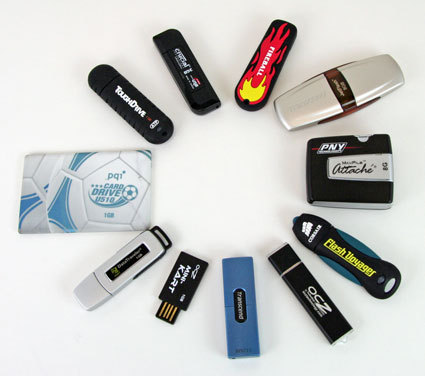Summer 2006 Memory Stick Fashion Show
21st Century Ultra Portable Storage
Every computer has at least a hard drive and an optical drive as standard equipment, but since the floppy drive went away, there hasn't been a standard portable storage solution. Floppy disks were slow and unreliable, ZIP drives never became serious options and recordable CDs or DVDs are too sensitive and too cumbersome to handle, even they offer sufficient capacity. Fortunately, Flash memory is here to fill the gap: it is fast and tiny, and the technology enables multi-gigabyte solutions at an affordable cost.
One way or another, Flash memory is used in almost every computer component or electronics device today. Think of your notebook, your cell phone or your car stereo - even your new microwave has a controller that stores data in Flash memory. These Flash applications use "NOR" Flash - based on the logical 'NOT-OR' operation - to store operating firmware or other data that does not change frequently. The most popular application model today, however, is flexible data storage for our everyday lives. Today's single-level cell (SLC) NAND Flash memory reaches up to 40 MB/s read performance and can accommodate up to 16 GB in the smallest form factors. Thanks to falling prices, Flash memory is on the verge of revolutionizing our digital lives, as mobile memory devices and MP3 players can now perfectly accommodate our digital assets and commodity data.
So, should everybody have a portable USB storage device? In fact, we believe that this really makes sense, because low-cost memory sticks at capacity points below 1 GB are fairly affordable, and even 2-4 GB devices are no longer out of reach. At some point, a USB memory device could hold all of your digital assets, such as email data, photos, projects, and so forth. Even better, the devices are robust and can usually be used as a key fob.
Those who now are concerned about safety of their data on a USB stick should look for software encryption solutions or password management software, or even invest in a memory stick with built-in data protection.
There is another application coming up for USB Flash memory products: Windows Vista will allow swapping main memory content to an available USB Flash drive to speed up application responsiveness. Given that Windows Vista will introduce a smart application prefetch mechanism called SuperFetch, having as much available memory as possible will be important. While a USB Flash memory device will not allow a system to outperform PC configurations with multiple gigabytes of physical memory, it can certainly help to speed up application switching if multiple programs are being executed. Given that memory sticks are available at less than $30, this investment really can make sense.
For this review, we took a look at 12 different devices on the memory market. Most of them are Flash based, but we also included a product that is based on a 1" hard drive - these are an attractive alternative for those who aren't looking for the absolute smallest dimensions.
Join our discussion on this topic
Get Tom's Hardware's best news and in-depth reviews, straight to your inbox.
Current page: 21st Century Ultra Portable Storage
Next Page "U3" Offers Extra Value
Patrick Schmid was the editor-in-chief for Tom's Hardware from 2005 to 2006. He wrote numerous articles on a wide range of hardware topics, including storage, CPUs, and system builds.
